Boots 'Beirette'
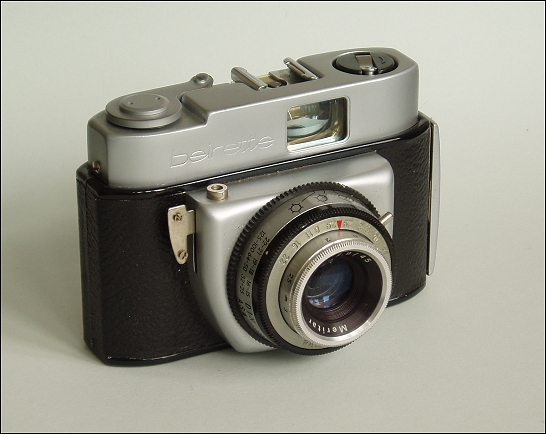
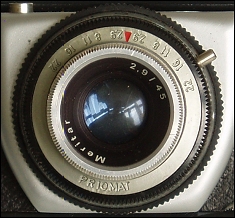
Boots, the chain-store chemist in the UK, re-badged and sold several cameras from a variety of manufacturers. This particular model, known as the 'Beirette' was sold around 1970.
The name 'Beirette' was applied to a long sequence of compact 35mm viewfinder cameras from 1958 to the 1980's and were manufactured in East Germany by the firm Beier. This 1970 model features a Priomat shutter with 1/125th, 60th, 30th and B settings. The lens is a Meritar f2.9 with a focal length of 45mm, usually regarded as a standard focal length for 35mm 'compacts'. A hot shoe and a contact for an external electronic flash are also featured.
Since the camera uses interchangeable lenses, a focal plane shutter is
employed. Although the shutter is rather noisy it is remarkably smooth,
probably due to the absence of a mirror to move, as is the case within an SLR. The shutter speeds are from 1 sec. to 1/500 sec. plus B, with flash
sync at 1/30th sec and a self-timer is included.
The main improvement over its predecessor, the FED 3, is its added uncoupled
selenium meter, with a window in front of the speed dial. The meter has a
scale on the user's left on the top-plate, with a match-needle linked to a
calculator dial. The placement of the meter calculator leaves the rewind as
a thumb-wheel neatly positioned on the side of the camera.
There were two versions of the FED4 manufactured, Type A & Type B. the FED
4A (made from 1964-1971) has a knob wind, with a plain front to the top
plate, with a large gap between the viewfinder window and the top, a
circular bezel around the rangefinder window and the name engraved on the
front, between and above the rangefinder and viewfinder windows. The FED 4B
(of which this is a fine example and made from 1969-80) has a lever wind and
rectangular borders to the rangefinder and viewfinder windows matching the
height of the meter window. The viewfinder is larger, and the name is
printed on the plate next to the rangefinder window.
The camera is of typical Russian robust construction, seemingly carved out
of a huge chunk of metal. It doesn't give the impression of a camera that
will fall apart. This camera is built to last.
Foto-Quelle marketed the FED 4 in Germany as the 'Revue 4'. Special editions
were produced for the 50th anniversary of the October Revolution in 1967 and
for the 1980 Olympic Games in Moscow.
My thanks to John Sykes for his kind donation of this camera.
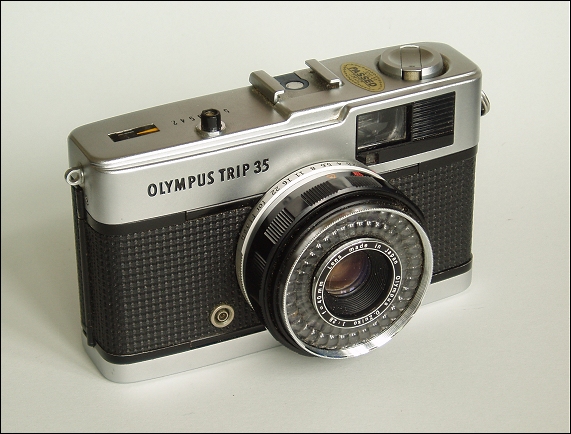
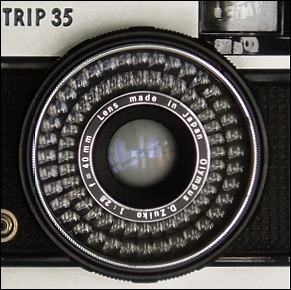
The 'Olympus Trip 35' was a very popular compact camera in the early 1970's. and copied in the 1990's by a poor plastic bodied 'toy' variety. This example however is one of the original designs.
It is a very robust 'point and shoot' camera and is well designed both mechanically and optically. It was promoted very successfully (and in particular its Multi-Coated Zuiko lens) by David Bailey, a British fashion photographer of the 1960's.
The auto exposure system uses a selenium photo-electric light meter which does away with the need for batteries. Film speeds can be set between ASA 25 and ASA 400. Once set, and with the aperture ring set to 'A', the camera will adjust the exposure as required. Focusing can be adjusted between 1 meter and infinity and the viewfinder has markers to indicate slight framing adjustments needed at close focusing settings to allow for parallax errors.
Ricoh 35S
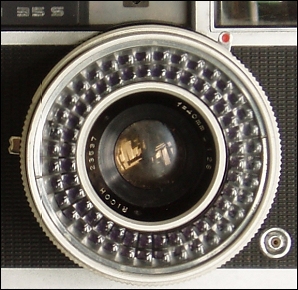
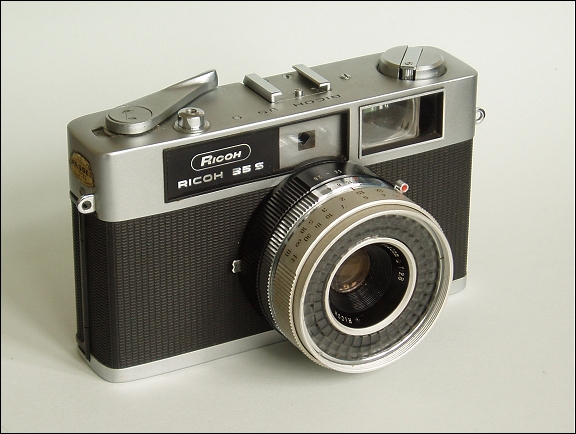
The Japanese firm Ricoh manufactured about 50 different kinds of camera between 1953 and 1980. For some reason several of them seem to have been given a model number of 35S.
This particular model was introduced in 1963 and uses a rangefinder for focusing and a selenium cell light meter with match needle metering in the viewfinder. The fixed non-interchangeable lens is a Ricoh 40mm f2.8. The camera has a modest range of shutter speeds from 1/4 to 1/300 sec. without a B setting but does incorporate a synchronized flash socket and a 10 second timer. The camera itself is rather heavy and 'chunky' compared with recent 35mm 'compacts'.
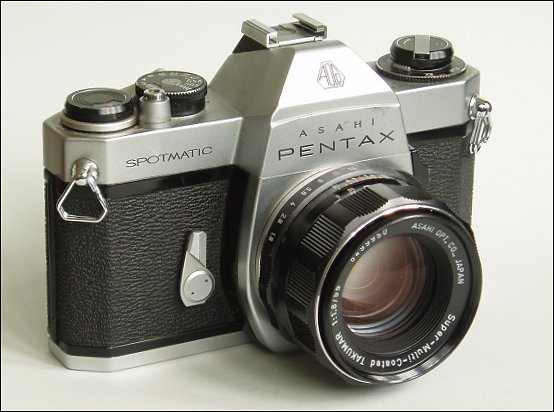
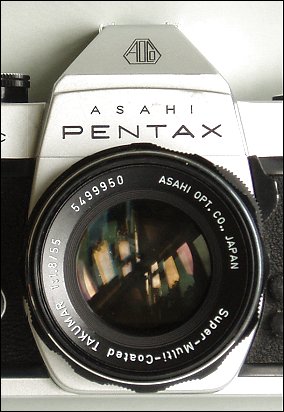
The Asahi Optical Co. of Tokyo, Japan were major innovators in the field of 35mm Single Lens Reflex design. They were the first Japanese company to produce an SLR camera and the first company worldwide to incorporate an instant return mirror into a camera.
The original 'Spotmatic' was introduced in 1964 and was the first camera to sell well with 'through-the-lens' light metering. The Spotmatic II was introduced seven years later in 1971 with several improvements and increased functionality.
The SP II incorporates a horizontal focal plane shutter with speeds ranging from 1 sec. to 1/1000th sec. It uses CdS Through The Lens (TTL) metering and has ASA range settings from 20 - 3200 ASA. It also has a hot shoe and self timer which were absent from the original Spotmatic design.
The camera body takes 42mm screw thread lenses which became a ubiquitous standard for many SLR manufacturers in Japan and indeed in East Germany on the Praktica range of cameras. Because of the popularity of the 42mm screw thread there was a huge range of lenses from independent lens manufactures that could be used. This particular camera is fitted with an f1.8, 55mm Super-Muti-Coated (SMC) Takumar lens (all 'Takumar' lenses are manufactured by Asahi Pentax). The camera was also available fitted with a physically larger and more expensive f1.4 lens, faster by one stop.
Slightly cheaper versions of this camera soon followed, minus the hot shoe and self timer and fitted with an f2 lens, namely the SP1000 (max. shutter speed 1/1000 sec. and the SP500 (1/500 sec). The SP500 however was capable of 1/1000 sec but oddly this speed was not engraved on the shutter speed selection dial.
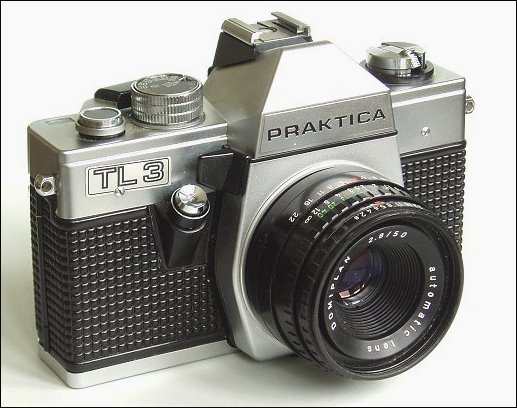

The Praktica TL3 was manufactured by Pentacon in Dresden, Germany between 1984 and 1986. It uses the then popular 42mm interchangeable screw thread lenses. This particular example is fitted with an f2.8 50mm Domiplan, the cheapest of the Pentacon range.
The camera employs a vertically moving metal blade shutter, replacing the horizontally moving shutter of earlier SLRs. Since the shutter 'slit' only needs to travel 25mm as apposed to 36mm, the vertical shutter allows for faster flash synchronisation speeds and eliminates horizontal distortion with fast moving subjects. The vertical shutter is now standard for most SLRs.
The TL3 has Through The Lens (TTL) metering with an ASA range of 12 - 1600. The eye level finder uses a Fresnel lens viewing screen with a microprism centre circle. This, together with a split image, makes accurate focussing very obvious. Flash is triggered via a hot shoe on top of the pentaprism but a socket for external flash is not supplied. Shutter speeds range from 1sec to 1/1000sec together with a B setting.
Although the Domiplan lens fitted to this camera is a very simple Cooke-triplet design and selling relatively cheaply, it gives very respectable results at apertures less than f4. Since the camera uses 42mm screw thread lenses, it can of course be fitted with the excellent Pentax 'Takumar' range of lenses together with a multitude of alternatives from independent lens manufacturers.
Russian FED 4
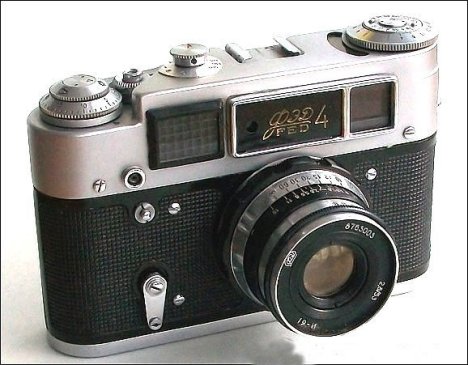
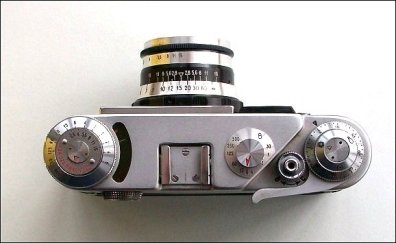
The FED4 rangefinder camera was produced by the FED factory in Kharkov, Ukraine from 1964 to 1980. It is fitted with a Leica-type M39 screw thread. The standard lens fitted to this example is a 53mm f2.8 Industar 61.